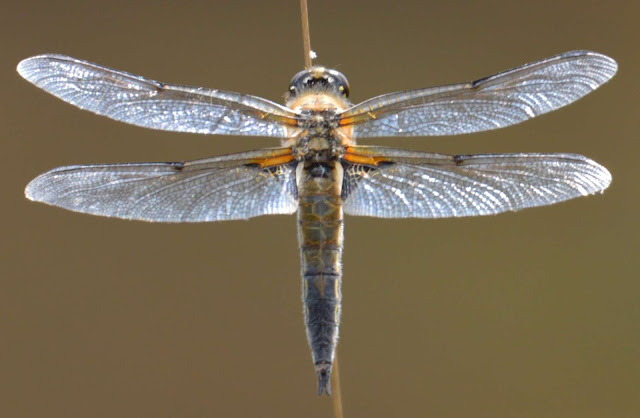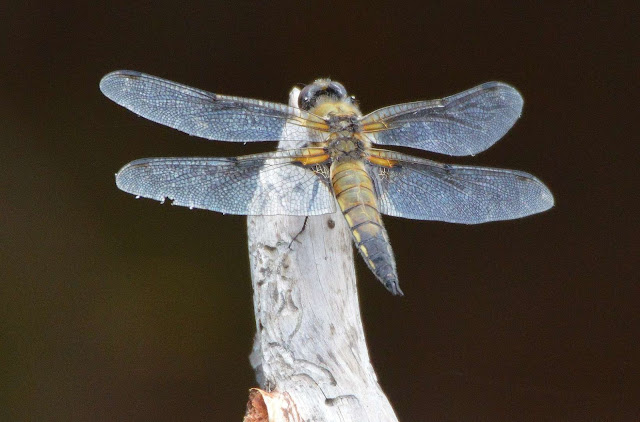It's also been festival season (along with work and life) and I have been to two in a row which were great but my body is now all festivalled out and now in recovery, good grief I need a holiday!
My walk today began locally. Not 4 miles away lies a disused car park in Gosport. An overgrown unimpressive brownfield site to some but to others with a keen eye on the natural world, it's a goldmine.
Predominately a butterfly hotspot with a backdrop of Wych Elm, Oak and bramble. The area is fenced off from the road to the north and east.
I met up with my walking pal Chris. We parked across the road which has a large area of woodland and overgrown grassland that leads down to Portsmouth Harbour. We concentrated on that area first.
There were a few Comma patrolling their territories and in between feeding on the bramble flowers.
As ever with this time of year Meadow Browns' were the most prevalent around, closely followed by Small Whites'
Marbled Whites were at their peak and showed well too. There were flowers all around, the grasses were high and the butterfliues took full advantage of this.
Holly Blues were showing their age and looked frayed around the edges but the focus of our attention was to lye high up in the Wych Elms.
White Letter Hairstreaks are fairly small and rare butterflies and spend the most of their time high in the canopy. Males were duelling rivals for the attention of the females. There were a handful spinning around the tree tops. They do occasionally descend to nectar on the bramble below but as with other times I have visited here I was out of luck once more.
I had to be grateful for the long distance shots I was able to obtain.
They can be so difficult to pick out when sat on a leaf. Can you see it in this shot?
To give our necks a little respite our attention turned to the earth beneath our feet. Small Skippers were numerous all around and fed on the Trefoil flowers
Back up to the canopy the Hairstreaks still proved elusive.
The hairstreak has done well to adapt to the Wych Elms. They used to favour English Elm until Dutch Elm disease decimated the population in this country just a few decades ago.
We gave up hoping they would descend for us and took a few more shots before heading just down the road.
A Meadow Brown was a novel sight just a few weeks ago but with so many around they can get a little overlooked. This one took my eye with its wing shading in the sunlight.
More skippers. This one is the rarer Essex Skipper which can be deciphered from the Small by the clubs at the end of the antennae. They are jet black in the Essex, as though dipped in ink, whereas the Small has some dark marks on them but the underside is a copper colour.
As we headed back to the vehicles a Cinnabar Moth posed nicely for us in the foliage.
Not a quarter of a mile south is one of the many forts that pepper the area.
Fort Brockhurst has a moat encircling it's walls and is a wonderful microcosm of a nature reserve in the middle of a large trading estate with suburbia on the periphery.
Coots have many territories here and one was busy feeding it's young.
Another overlooked creature, they are quite striking when you stop and observe for a while, the red eye so striking against the contrasting black plumage and white bill.
I was clicking away at the Damselflies randomly as they passed beneath us. I happened to capture a rare Small Red Eyed Damselfly that are common here but not nationally. My only sighting today but they would emerge in greater numbers later on.
A hunting Emperor Dragonfly threw down the gauntlet to try and capture it's swift movements on the wing. We gladly accepted and I was happy with my labours.
It did occasionally rest for an easier photo opportunity
As did the many Damselflies.
An Azure....
Red Eyed...
another Red Eyed
and a Blue Tailed....
 We carried on our circular walk of the fort, every few feet there are platforms used for angling which provide great vantage points for viewing the wildlife. Even this Red Admiral used it for a bit of sunbathing by our feet.
We carried on our circular walk of the fort, every few feet there are platforms used for angling which provide great vantage points for viewing the wildlife. Even this Red Admiral used it for a bit of sunbathing by our feet.Across from one of these I spotted terrapins resting in the middle of the moat. One of the consequences of the passing addiction to Mutant Ninja Turtles many years ago, unwanted pets were released into the environment. Their impact being a non native species is still hard to judge. These look like Red Eared Terrapins from North America. One thing is certain, they need a temperature of around 25 degrees celsius for around 60 days to incubate eggs, so breeding is highly unlikely in our climate!
Breeding is definitely not a problem for the Emperor Dragonfly. This female is ovipositing in the weedy moat.
On the wing we caught up with these mating Four Spotted Chasers....
More Red Eyed Damselflies could be seen all around but no Small Red Eyed
We were reaching the end of the circular walk around the fort. This Large Red Damselfly sat nicely for a photo.
The Emperor kept ovipositing before us...
Four Spotted Chaser gave us some great forward and aft views as it perched for a breather during it's seemingly endless forays around the moat.
The moat is full of fish either large or small, from what I could make out, this looked like a Roach
We had come full circle and had reached the vehicles once again. As I gazed at these roosting Black Headed Gulls we pondered our next destination. It had been a morning of Dragons, so why not continue our quest for some more of these ancient aerial masters in the afternoon ?
Thursley Common is one of the largest heathlands in Surrey and possibly the most important. It is host to a myriad of species and boasts areas of marsh, woodland and lowland heath.
The most obvious species here are the Dragonfly and Damselfly or to give them their scientific suborder names, Anisoptera and Zygoptera respectively.
It's quite a journey to get there but it's well worth the effort. This stunning Large Red Damselfly greeted us on our arrival.
The main area along the footpath is a mass of bogs and pools which are the perfect habitat for these creatures. Another Four Spotted Chaser posed beautifully in the sharp intense sunlight.
It was very hot so I was glad of my hat , sunscreen and water.
Chris and I had visited here last year. Back then we had suffered a wet spring so the area was extremely boggy. This year however it was the opposite. Areas we would never had dared walk across were now easily accessible. Sundew are common here but they were struggling to cling on to life in many areas due to the drought.
Marsh Orchids could be seen occasionally but were coming to the end of their days.
Four Spotted Chasers were still full of life however....
Large Red Damselflies once more
and Common Blue...
The Four Spotted Chasers just seemed to be everywhere
Something new turned up, a Black Tailed Skimmer this time that sat basking on the sand before us.
Then a Keeled Skimmer...
Our avian friends love this place too. We could hear the jangling tune of a male Reed Bunting and found it tucked away in a small tree.
Having left the main sandy path we continued along the boardwalk that took us along the edge of the main lakes. Damselflies and Dragonflies swarmed around us going about their business of hunting, mating and defending territories. This is the end of their days. After spending so much time living subterraneously these are their last days on earth and boy do they go out with enthusiasm.
Chris was walking ahead of me and exclaimed as one Dragonfly decided to use his hand as a perching place.
This Black Tailed Skimmer was missing a wing and was having trouble flying properly.
Many years ago, Dragonflies were known as Horse Stingers but they definitely do not sting. The do have a tendency to bite however as Chris found out as he shouted his painful disapproval !
The vegetation surrounding the boardwalk was alive with Damselflies and after detailed surveillence I came across a Small Red, my first ever.
Plenty of Keeled Skimmers too.
Then back on the Small Red
Mating Common Blue Damsels
Keeled Skimmer...
and another four spotted chaser
Some Orchids were still showing, this is a rather new and special Heath Spotted Orchid
The boardwalk is quite long and having traversed half it's length we enquired about the chances of a sighting of a Hobby to a passing naturalist. 'Your best bet would be later on in the afternoon' he told us. 'Damn!' I thought, I was hoping to see one here as they love to hunt Dragonflies.
We past by another couple of chaps sat on the boardwalk and asked if they had seen any.'There's one just coming this way mate' he exclaimed. Que scramble for camera as the said bird spiralled into view pulling all manner of aerial contortions in pursuit of it's prey!
A very brief glimpse of such a jaw dropping master of the air but thrilling nonetheless.
Having caught our breath but having no more luck locating this awesome hawk our attention inevitably drew back to the nearer distance. More Large Red Damsels and Four Spotted entertained us, although our eyes continued to look furtively to the skies in case of a return pass.

There is a lot of low growing heather and we are always on the lookout for Black Darters which inhabit these plants. Chris found a female resting quietly
Yet more Four Spotted and I couldn't resist lifting the lens once more.
We were nearing the end of the day but there was one more Damselfly I wanted to see and it duly obliged. A stunning female Emerald Damselfly with what looked like a kink in it's tail.
As our busy day drew to a close, some juvenile Mallard and their mother fed in the shallow pools
Sundew clung on to every available place they could in a drought
and some last photos of Large Red Damsels
plus a speciality here, Bog Asphodel...
Then to round our day off, a Large Skipper flew in and agreed to have it's photo taken on a fern.
It was really good to return to Thursley. We really must spend the day here. There is so much to see and a couple of hours really didn't do it justice. Now when I retire........ ;)
The title of this post is an excerpt taken from the poem 'Dragonfly' by April Dawn







































































































No comments:
Post a Comment
Please leave me a message if you would like to do so.